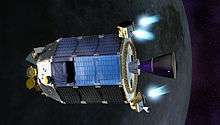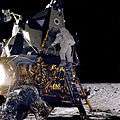SkyFire (spacecraft)
 | |
| Mission type | Technology demo, reconnaisance |
|---|---|
| Operator | Lockheed Martin |
| Spacecraft properties | |
| Spacecraft | SkyFire |
| Spacecraft type | CubeSat |
| Bus | 6U |
| Manufacturer | Lockeed Martin |
| Launch mass | 14 kg (31 lb) |
| Dimensions | 10×20×30 cm |
| Start of mission | |
| Launch date | November 2018 |
| Rocket | SLS Block 1 |
| Launch site | Kennedy LC-39B |
| Flyby of Moon | |
SkyFire is a planned nanosatellite spacecraft that will fly by the Moon and collect surface spectroscopy and thermography.
Mission
Its purpose is that of a Geosynchronous Earth Orbit (GEO) technology demonstration using a low-cost 6U CubeSat spacecraft. SkyFire will perform a lunar flyby, collecting spectroscopy and thermography for surface characterization, remote sensing, and site selection.[1] The spacecraft includes two deployable solar arrays and will have a total mass of about 14 kg (31 lb).
SkyFire was selected in April 2015 by NASA's NextSTEP program (Next Space Technologies for Exploration Partnerships) and awarded a contract to Lockheed Martin Space systems worth $1.4 million for further development.[2][3][4]
Launch
It will fly along other 12 CubeSats as a secondary payload mission on the first flight of the Space Launch System, Exploration Mission 1 (EM-1) scheduled to launch in 2018.[5]
Propulsion
SkyFire will also demonstrate a low thrust electric propulsion rocket engine technology called electrospray propulsion to lower the spacecraft's orbit for more science and technology mission objectives.[6]
See also
References
- ↑ Williams, Greg; Crusan, Jason (April 2015). "Pioneering Space –the Evolvable Mars Campaign" (PDF). NASA. Retrieved 2015-05-26.
- ↑ Morring, Frank (24 April 2015). "Habitats Could Be NASA's Next Commercial Spacecraft Buy". Aviation Week. Retrieved 2015-05-26.
- ↑ Clark, Stephen (8 April 2015). "NASA adding to list of CubeSats flying on first SLS mission". Spaceflight Now. Retrieved 2015-05-25.
- ↑ Krebs, Gunter Dirk (19 May 2015). "Skyfire". Gunter's Space Page. Retrieved 2015-05-26.
- ↑ Space Launch System's First Flight to Send Small Sci-Tech Satellites Into Space. Space Ref. February 2, 2016
- ↑ "Next Space Technologies for Exploration Partnerships (NextSTEP) Projects". NASA. NASA. May 5, 2015. Retrieved 2016-02-05.

